|
|
| Design Options |
 |
|
Before you start designing forms you can customize your design
environment to suit your own preferences. To view the current design
environment settings, select Options from the Tools
menu.
|
| Preferences |
|
On the Preference tab,
you can set the following options:
- Measurement units -
allows you to select the unit of measurement used for all design
functions. Options include millimetres, centimetres, inches, points,
picas and 300dpi.
- Paste at - allows you
to select where an object pasted from the clipboard will be inserted.
- Printer driver warning
- a warning is given when an incompatible printer is selected.
- Reload project -
FTDesign automatically reloads the last project on start up.
- Double click on structure map
pane acts as 'Go' - when selected, double-clicking on a page
element in the structure map pane will place that page element in focus
in the design window.
- Language - Changes the
language used in FTDesign, FTSplitDef and the Repaginator. These
applications must be restarted in order for this change to take effect.
FTDesign, FTSplitDef and the Repaginator will now be displayed in the
selected language, including menus, dialog boxes, field names and page
element names.

|
|
| Top
|
| Folders |
|
On the Folders tab, you
can set the following options.
- Forms and Project definitions
directory - default directory when opening and saving a new form.
Select Use last selected folder to set the default
form and project directory to the last folder selected when opening or
saving a form or project.
- Pictures, logos
directory - default directory when inserting a picture or a logo on the
form. Select Use last selected folder to set the
default picture directory to the last folder selected when inserting a
picture.
- Built projects directory
- default directory for output built project (.asc) files.
- Substitution files directory
- default directory for test substitutions files.
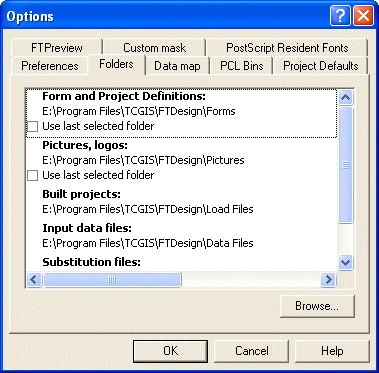
|
|
| Top
|
| Data Map |
|
On the Data map tab, you
can set the following options
- Revert to 'Select' mode after
mapping - after a data field is mapped, the cursor will
return to select mode.
- Apply underlying text after
move/resize - when a test field is moved to another data
field, the rule will change so it reflects the new data.
- Colors - select your
own colors for print mapping in Print Line mode.
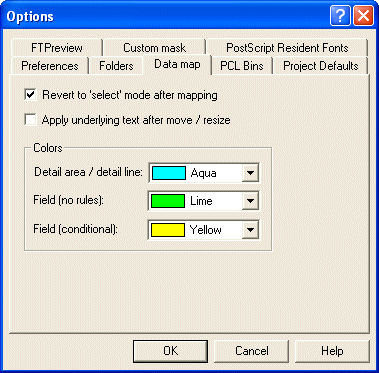
|
|
| Top
|
| PCL Bins |
Available custom PCL bins store the required attributes to force the
printer to select other than the normal bin for input and output. Input
is for paper selection, output for is destination. This section assumes
you will give preference to one of PCL (PCL5e or PCL5c) or PCLXL (PCL6)
for your bin selections for custom bins as they may be different.
PostScript bins cannot be permanently labeled in this fashion as they
are provided by the printer driver.
On the PCL Bins tab, you
can set the following options:
- Name - the name of the
custom printer bin to be displayed in FTDesign. Custom PCL Bins are
used to define extra printer input and output bins when the printer
driver does not make them visible.
- Bin type - set whether
the custom bin is an input tray or output bin.
- PCL Escape - set the
numeric part of the PCL escape code for selecting the custom bin. This
value can be found in your printer manual.
You can edit the preferences of any custom
PCL bin at anytime by simply left-clicking the appropriate bin in the Available
custom PCL bins box and changing the settings. PCL bins are
only available when a PCL printer driver has been selected.
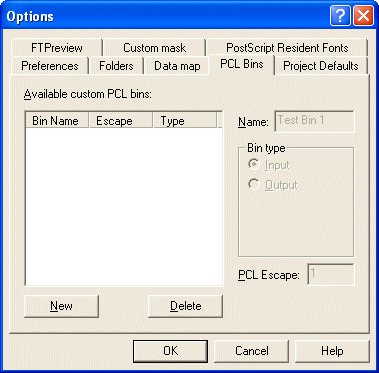
|
|
| Top
|
| Project Defaults |
Project defaults are used to initialize newly created projects and when
the stand-alone form is viewed using the preview options.
On the Project defaults
tab, you can set the following Font usage and MICR options:
- All - FormTrap uses a
combination of True Type fonts and printer-resident fonts when
designing and building your form. Once All is
selected you can then set the following options:
- Prefer True Type Fonts
- defaults to True Type fonts on all new projects. FormTrap uses True
Type fonts instead of printer-resident fonts when both are present i.e.
font 'Arial' exists both as a printer-resident and system based True
Type font). Prefer True Type Fonts is the default
option. Uncheck this box to default to printer-resident fonts on all
new projects.
- Always build fonts -
when FormTrap cannot find either the True Type or printer-resident
fonts it will substitute the next best fit for the missing font. Check
this box to ignore font related errors or when the exact appearance of
text glyphs is irrelevant.
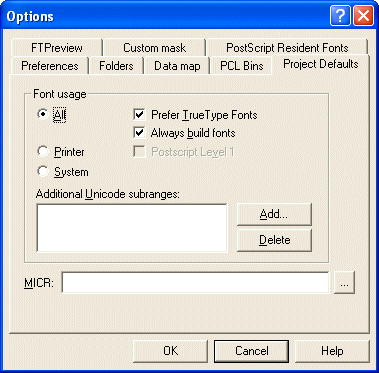
- Printer - FormTrap
uses only printer-resident fonts when designing and building your form.
Printer-resident fonts are installed on the printer. Once Printer is
selected, you can then set the following option:
- Post Script Level 1
- produces Postscript Level 1 output files. This option is generally
used for specific faxing solutions that require Postscript Level 1
input.
- System - FormTrap uses
only True Type fonts when designing and building your form. True Type
fonts are installed in your Windows font directory.
- Add Unicode subranges
- this allows you to include additional ranges of character glyphs into
your load (.ASC) file. Subranges are supplied by TCG during the
installation and on request. To add a new Unicode subrange:
- Click the Add
button. The Unicode subranges dialog box will open.
- Select from the list of available
subranges and click the OK button.
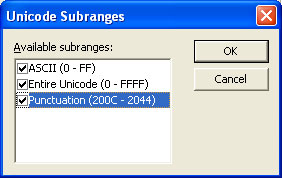
- MICR - Select a
default MICR file for all new projects. The MICR box refers to the
location of the MICR font file you are using to generate the MICR line
on check forms. The MICR font is only available when using a PCL
printer driver to design and build forms.
- Click the browse "..."
button and locate the MICR directory.
- Select the correct MICR file and
click the OK button.
- If you are not producing checks
(cheques) or you are not using the PCL printer driver you can ignore
this option.
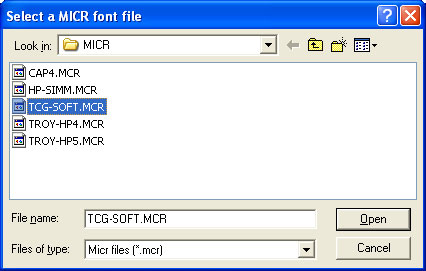
|
|
| Top
|
| FTPreview |
On the FTPreview tab, you can set the
following options:
- Try to match using form title
- FTPreview will try to find a data file which matches the title of the
form. For example, if the form is named invoice.frm, FTPreview will
look for a data file called invoice.txt or invoice.dat in the specified
Input data files folder.
- Default data file -
click the browse "..." button to select a default
sample data file. If a data file has not been loaded FTPreview will use
the specified data file as the default.
- Launch maximized - the
FTPreview window will open maximized.
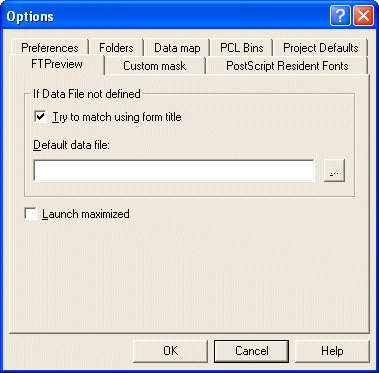
|
|
| Top
|
| Custom Mask |
On the Custom mask tab, you can set the following
options:
- New - create a new
custom amount mask. This is useful if you regularly use a currency
format that is not available in the default list. The new mask will
then be available in the list of mask types.
- Edit - edit the format
of an existing custom mask.
- Delete - delete an
existing custom mask.
More information on Creating Custom Masks
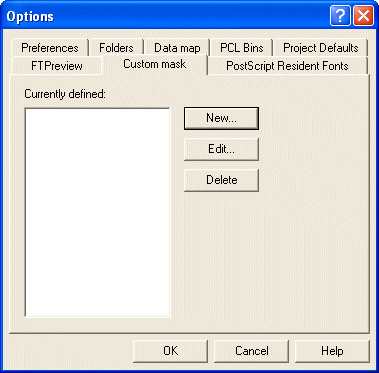
|
|
| Top
|
| Postscript Resident Fonts |
On the PostScript Resident Fonts tab, you
can add additional fonts which can be used when designing a form.
The following options are available:
- New - Use the New...
button to add a font to the available font list.
- You will need to determine the name the
printer uses for the font you wish to add. You can find the font name
by printing a list of the printer resident PostScript fonts from the
production printer.
- Enter the Family name
for the font and the Style suffixes for Regular,
Bold, Italic
and Bold Italic.
- Click the OK button.
- Edit - edit the
information for an already available PostScript font. Select the
appropriate font and click the Edit button.
- Delete - delete a
PostScript font from the list of available FTDesign fonts. Select the
appropriate font and click the Delete button.
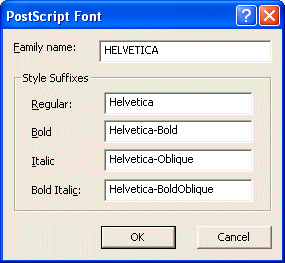
|
|
| Top
|
|
|
|

 Design Window
Design Window Design Options
Design Options  Preferences
Preferences  Folders
Folders  Data map
Data map  PCL Bins
PCL Bins  Project defaults
Project defaults  FTPreview
FTPreview  Custom mask
Custom mask  PostScript Resident Fonts
PostScript Resident Fonts 









